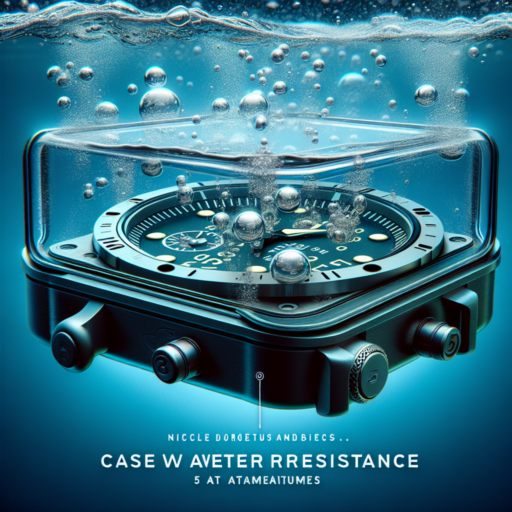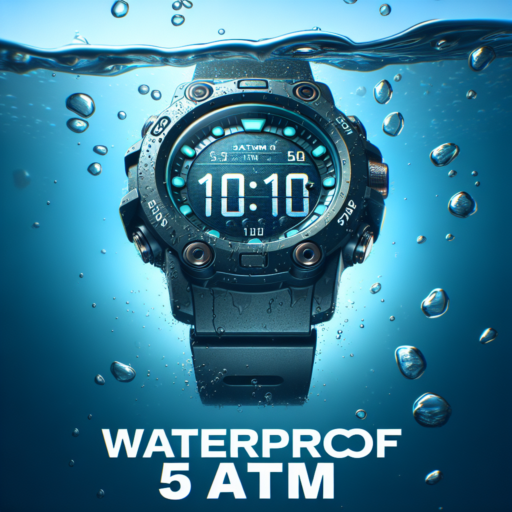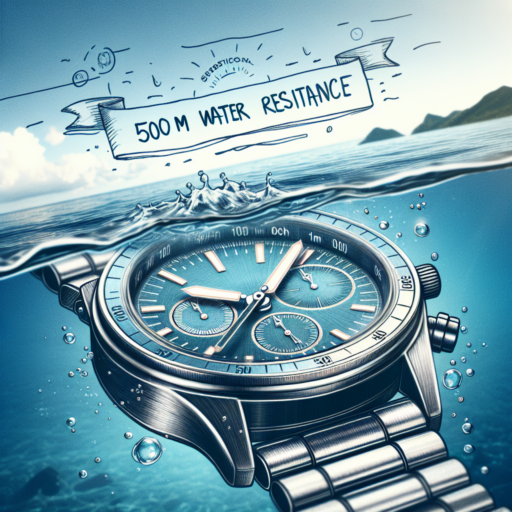Understanding Case Water Resistance: What Does 5 ATM Mean?
Water resistance ratings are a crucial aspect of watches, indicating their capability to withstand pressure underwater. Among these ratings, 5 ATM (Atmospheres) represents a specific level of resistance. To understand what this means, it’s essential to dive into the characteristics and implications of a 5 ATM rating. This measure is not just a random number but a reflection of the watch’s ability to withstand pressures equivalent to those found 50 meters below the surface.
However, a common misconception is that a watch with a 5 ATM rating is suitable for prolonged swimming or diving activities. This rating, while indicative of a certain degree of water resistance, actually suggests that the watch can handle minor water exposure such as hand washing, rain, or brief immersion. Activities that involve high-velocity water, such as showering, water sports, or diving, may exert pressures on the watch that exceed those covered by the 5 ATM rating.
The testing process behind determining a watch’s water resistance level, particularly the 5 ATM specification, includes a series of rigorous conditions not typically encountered in everyday life. Manufacturers use specialized equipment to simulate the pressures and durations their watches can endure. However, it’s crucial for users to understand that the integrity of a watch’s water resistance can deteriorate over time due to wear and tear, impacting gaskets and seals. Thus, regular maintenance and check-ups are recommended to ensure the watch’s water resistance level remains intact.
How Case Water Resistance is Measured: Exploring the ATM Rating System
Understanding how water resistance is measured in cases, especially for devices such as watches, is crucial for users who frequently engage with water-related activities. The ATM rating system, standing for «atmospheres,» is the industry standard for classifying the degree of water resistance an item possesses. This system offers a more nuanced understanding of what each device can withstand, moving beyond mere labels of ‘water-resistant’.
ATM ratings are not as straightforward as they might seem; for instance, a watch with a 3 ATM rating is not suitable for diving but can withstand splashes or brief immersion in water. The rating indicates the pressure a device can withstand under static conditions, not the actual depth for dynamic activities. A 5 ATM rating suggests suitability for swimming in shallow depths, whereas higher ratings like 10 ATM or more are robust enough for diving.
Understanding ATM Ratings
- 3 ATM: Splash resistant – Not suitable for swimming or diving.
- 5 ATM: Suitable for shallow water swimming, but not diving or high-speed water sports.
- 10 ATM: Suitable for snorkeling and swimming but not for high-impact water sports or deep-sea diving.
It’s essential for consumers to not only look at the ATM rating but also understand the activities each rating supports. Misinterpreting these ratings can lead to potentially damaging your device, mistakenly taking a 3 ATM rated watch for a deep dive can have deleterious effects. Therefore, a clear comprehension of what each ATM rating permits in terms of water exposure is key to maintaining the integrity of your water-resistant devices.
The Importance of 5 ATM Water Resistance in Everyday Watches
Understanding the value of 5 ATM water resistance in everyday watches is essential for both casual wearers and enthusiasts. This specification not only signifies a watch’s durability but also its ability to withstand pressures equivalent to a 50-meter depth. For individuals leading an active lifestyle or simply seeking reliability in their timepiece, this feature offers profound peace of mind.
5 ATM water resistance is not just about the ability to go swimming or dive shallow depths without worry; it’s also about protecting the watch’s internal mechanisms from dust, sweat, and occasional splashes. These are common encounters in daily life, making 5 ATM water-resistant watches a practical choice for everyday wear. Whether you’re washing your hands, caught in a rainstorm, or enjoying a day at the pool, a watch with this level of protection ensures that your timepiece remains functional and unharmed.
Incorporating this feature, manufacturers aim to enhance the longevity and durability of their watches. The additional layers of sealing and protective measures required for 5 ATM resistance not only guard against water but also add to the watch’s overall robustness. Therefore, investing in a 5 ATM water-resistant watch can be seen as investing in quality and durability, aspects that are highly valued in the world of horology.
No se han encontrado productos.
Comparing Water Resistance Levels: 5 ATM vs. 10 ATM vs. 20 ATM
When selecting a watch, understanding the difference in water resistance levels marked as 5 ATM, 10 ATM, and 20 ATM is essential for choosing a timepiece that suits your lifestyle. Each rating signifies how well a watch can withstand water pressure, with the numbers indicating the atmospheric pressure it can endure. This article delves into how these different levels affect your watch’s performance in water-related activities.
Understanding 5 ATM Water Resistance
Watches rated at 5 ATM are designed to withstand pressures equivalent to a depth of 50 meters. This level of water resistance suggests that these watches are suitable for everyday use and can handle light splashes, rain, and handwashing. However, they are not intended for swimming or diving. Engaging in such activities with a 5 ATM rated watch could lead to water damage and impact its functionality.
The Versatility of 10 ATM Water Resistance
A step up from 5 ATM, watches with a 10 ATM water resistance rating can endure pressures up to 100 meters deep. This makes them ideal for swimming, snorkeling, and similar water activities, but not for high-impact water sports or deep-water diving. For those who lead an active lifestyle but do not delve into the depths of the seas, a 10 ATM rated watch offers a balance between functionality and water resistance.
Exploring the Depths with 20 ATM Water Resistance
At the pinnacle of water resistance, 20 ATM rated watches are engineered for serious underwater activities, including scuba diving to depths of 200 meters. These watches are built to withstand significant water pressure, making them perfect for deep-sea exploration. If your adventures take you below the surface, a watch with a 20 ATM rating offers the robustness and reliability needed to accompany you into the depths.
Can You Swim with a 5 ATM Water-Resistant Watch? Clearing the Misconceptions
The question of whether you can swim with a 5 ATM water-resistant watch is one that lingers in the minds of many watch enthusiasts and casual swimmers alike. The terminology and numbers can often seem confusing, but understanding what 5 ATM stands for is key to clearing up these misconceptions. ATM, which stands for atmospheres, measures the level of water resistance. Therefore, a 5 ATM rating suggests that the watch can withstand pressures equivalent to a depth of 50 meters. However, this does not directly translate to suitability for all types of water activities.
It’s essential to differentiate between water-resistant and waterproof. No watch is truly waterproof, a term which suggests an absolute defense against water ingress under any circumstances. Water-resistant watches, including those rated 5 ATM, are designed to survive incidental contact with water such as rain, hand washing, or even brief immersion. When it comes to swimming, the situation becomes slightly more complex. The motion of swimming can increase the pressure on a watch significantly, beyond what static immersion would exert at the same depth.
Understanding the Limitations
While a 5 ATM water-resistant rating indicates that a watch can withstand pressures up to 50 meters deep, swimming involves dynamic movements that can momentarily increase pressure levels on the watch. This is particularly true for activities such as diving or vigorous swimming. Thus, if you’re planning to take a leisurely swim, a 5 ATM rated watch might hold up well. However, it is strongly recommended to consult with the watch manufacturer or a professional before deciding to swim with it regularly as different brands might have varying recommendations for their products.
Maintaining Your 5 ATM Water Resistant Watch: Tips and Advice
Maintaining a 5 ATM water-resistant watch requires a blend of routine care and mindful usage to ensure its longevity and optimal performance. These timepieces are engineered to withstand pressures equivalent to a depth of 50 meters or 164 feet underwater, making them suitable for daily wear, swimming, and cold showers. However, to maintain their resilience against water, certain precautions and maintenance steps must be rigorously followed.
Cleaning Your Watch
Regular cleaning is vital for maintaining the aesthetic and functional integrity of your 5 ATM water-resistant watch. After exposure to saltwater or chlorine, rinse your watch under lukewarm running water and dry it with a soft, lint-free cloth. This process prevents salt and chlorine deposits from corroding the seals that keep your watch water-resistant. Additionally, use a soft brush to gently remove any dirt or sand that might have been lodged in crevices.
Avoiding Extreme Temperature Changes
Exposure to extreme temperature changes can compromise the water-resistant seals of your watch. It is advised to avoid activities like entering a sauna or taking a hot bath while wearing your watch, as the rapid temperature changes can cause the seals to expand and contract, potentially allowing water ingress. Moreover, extreme cold conditions should also be avoided to maintain the integrity of your watch’s water-resistant capabilities.
Note: While 5 ATM water-resistant watches are durable and designed for active use, they are not invincible. Handling your watch with care and performing regular maintenance checks can significantly extend its lifespan and ensure it remains a reliable companion for your adventures.
Top Watches with 5 ATM Water Resistance Feature: A 2023 Guide
In 2023, the pursuit of durable and functional timepieces has led many to consider the 5 ATM water resistance feature as a critical benchmark. This measure, signifying the ability to withstand pressures equivalent to a depth of 50 meters, offers a blend of robustness and versatility for both everyday wear and recreational water activities. Exploring the top watches that boast this feature reveals a fascinating mix of technology, design, and reliability.
Among the leading contenders, renowned brands have pushed the boundaries in incorporating the 5 ATM water resistance attribute without compromising on elegance and style. These watches are not only equipped to handle splashes and brief submersions but are also meticulously crafted to cater to the aesthetic preferences of a discerning clientele. From sleek, minimalist designs to more rugged, sporty models, there is a 5 ATM water-resistant watch to match every taste and lifestyle.
The significance of choosing a watch with the 5 ATM water resistance feature in 2023 cannot be overstated. It offers peace of mind to those leading an active lifestyle or those simply seeking a reliable timepiece that can survive unexpected encounters with water. Moreover, the feature is now found across a wide range of price points, making it accessible to a broader audience. The quest for the perfect combination of functionality, durability, and style in a 5 ATM water-resistant watch continues to be a key trend in the horological world.
What Activities are Suitable for Watches with 5 ATM Resistance?
Watches with 5 ATM (atmospheres) resistance are designed to withstand pressures equivalent to a depth of 50 meters underwater. This level of durability makes them suitable for a range of activities, beyond just telling the time. Understanding the capabilities and limitations of these watches can help users choose the appropriate occasions to wear them, ensuring both the functionality and longevity of the timepiece.
Everyday Wear and Mild Physical Activities
For those looking for a watch that can handle daily activities without worry, a 5 ATM resistant watch is an excellent choice. These watches are perfectly equipped to handle activities such as hand washing, rain exposure, and even showering, although it’s often advised to avoid hot showers to prevent potential damage from steam. Moreover, they are suitable for physical activities that involve minimal water exposure, such as jogging or yoga, making them versatile companions for most everyday situations.
Swimming and Snorkeling
When it comes to water-based activities, watches with 5 ATM resistance are capable of handling shallow water swimming and snorkeling. For casual swimmers, these watches offer the convenience of not having to remove your watch before diving into a pool. However, it is important to note that they are not intended for diving or high-speed water sports, as these activities might exert pressure beyond what the watch can withstand, potentially leading to water damage.
It’s essential for owners to understand the specific limitations associated with their 5 ATM resistant watch. While these watches offer a degree of freedom and durability for various activities, they are not indestructible. Careful use during recommended activities will ensure that the watch maintains its accuracy and longevity, providing the wearer with a reliable timepiece for both daily use and recreational water activities.
Understanding the Limitations of 5 ATM Water Resistance in Smartwatches
When considering a smartwatch with a 5 ATM water resistance rating, it’s essential to understand what this specification truly entails and its limitations. A common misconception is that a 5 ATM rating equates to complete waterproof capabilities; however, this is not entirely accurate. This understanding is critical for users who intend to use their devices in various water-related activities.
The term 5 ATM refers to the watch’s ability to withstand pressures equivalent to a depth of 50 meters underwater. While this might sound impressive, it’s important to note that this rating primarily indicates the device’s durability against water ingress during specific conditions rather than under all possible scenarios. Activities that involve high-velocity water, such as water skiing or diving into a pool, can generate pressures that exceed those found at 50 meters depth, potentially leading to water damage.
Another aspect to consider is the nature of the 5 ATM testing itself. These tests are conducted in controlled environments, assuming static pressure conditions without taking into account temperature variations and chemical exposures such as chlorine in pools or salt in seawater. Over time, these factors can degrade the seals and gaskets that keep the water out, thus reducing the efficacy of the water resistance rating. Wear and tear from regular use can also compromise the watch’s water resistance over time, making it susceptible to water damage even if it has never been submerged beyond the advised limits.
FAQs on 5 ATM Water Resistance: Everything You Need to Know
When exploring the features of watches, fitness trackers, or any wearable technology, the term 5 ATM water resistance often appears, raising several questions about its meaning and implications for the use of these devices. This water-resistance rating is deemed critical by manufacturers and users alike, providing a significant edge in terms of durability and functionality in varying conditions.
5 ATM water resistance signifies that a device can withstand the pressure equivalent to a 50-meter depth under water, making it suitable for activities such as showering, swimming, or snorkeling. However, it’s crucial to recognize that this does not imply the device is invulnerable to all forms of water damage. Variables such as temperature change, steam, and chemical exposure can affect the integrity of the water resistance over time.
Many users wonder about the maintenance and care necessary to uphold the 5 ATM water resistance rating. It’s advisable to rinse the device with fresh water after exposure to chlorinated pools, saltwater, or soaps to maintain the seals and water resistance capability. Also, while the device may survive a dip into water, engaging in high-impact water sports may exceed the pressure limits, challenging the device’s water resistance capacity.




